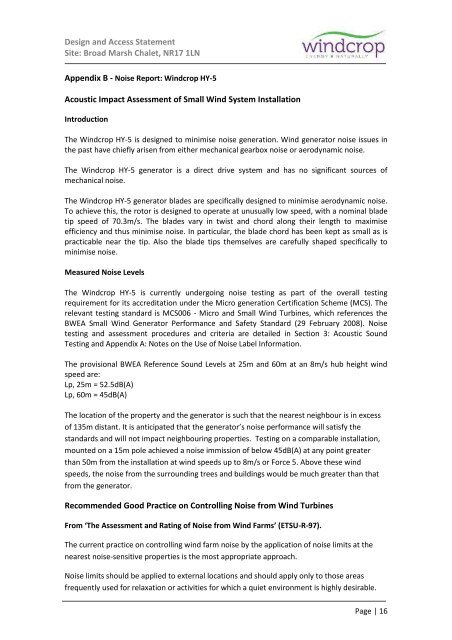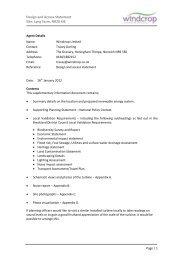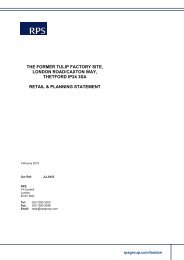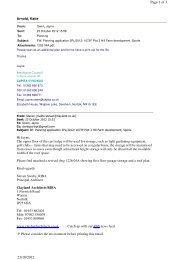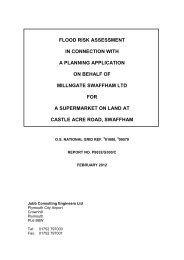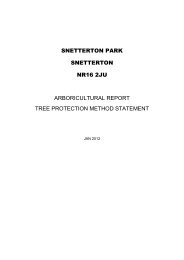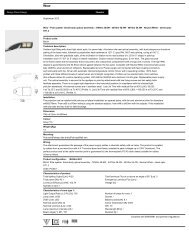Design and Access Statement Site: Broad Marsh Chalet, NR17 1LN
NR17%201LN%20Design%20and%20Access%20Statement.pdf
NR17%201LN%20Design%20and%20Access%20Statement.pdf
You also want an ePaper? Increase the reach of your titles
YUMPU automatically turns print PDFs into web optimized ePapers that Google loves.
<strong>Design</strong> <strong>and</strong> <strong>Access</strong> <strong>Statement</strong><br />
<strong>Site</strong>: <strong>Broad</strong> <strong>Marsh</strong> <strong>Chalet</strong>, <strong>NR17</strong> <strong>1LN</strong><br />
Appendix B - Noise Report: Windcrop HY-5<br />
Acoustic Impact Assessment of Small Wind System Installation<br />
Introduction<br />
The Windcrop HY-5 is designed to minimise noise generation. Wind generator noise issues in<br />
the past have chiefly arisen from either mechanical gearbox noise or aerodynamic noise.<br />
The Windcrop HY-5 generator is a direct drive system <strong>and</strong> has no significant sources of<br />
mechanical noise.<br />
The Windcrop HY-5 generator blades are specifically designed to minimise aerodynamic noise.<br />
To achieve this, the rotor is designed to operate at unusually low speed, with a nominal blade<br />
tip speed of 70.3m/s. The blades vary in twist <strong>and</strong> chord along their length to maximise<br />
efficiency <strong>and</strong> thus minimise noise. In particular, the blade chord has been kept as small as is<br />
practicable near the tip. Also the blade tips themselves are carefully shaped specifically to<br />
minimise noise.<br />
Measured Noise Levels<br />
The Windcrop HY-5 is currently undergoing noise testing as part of the overall testing<br />
requirement for its accreditation under the Micro generation Certification Scheme (MCS). The<br />
relevant testing st<strong>and</strong>ard is MCS006 - Micro <strong>and</strong> Small Wind Turbines, which references the<br />
BWEA Small Wind Generator Performance <strong>and</strong> Safety St<strong>and</strong>ard (29 February 2008). Noise<br />
testing <strong>and</strong> assessment procedures <strong>and</strong> criteria are detailed in Section 3: Acoustic Sound<br />
Testing <strong>and</strong> Appendix A: Notes on the Use of Noise Label Information.<br />
The provisional BWEA Reference Sound Levels at 25m <strong>and</strong> 60m at an 8m/s hub height wind<br />
speed are:<br />
Lp, 25m = 52.5dB(A)<br />
Lp, 60m = 45dB(A)<br />
The location of the property <strong>and</strong> the generator is such that the nearest neighbour is in excess<br />
of 135m distant. It is anticipated that the generator’s noise performance will satisfy the<br />
st<strong>and</strong>ards <strong>and</strong> will not impact neighbouring properties. Testing on a comparable installation,<br />
mounted on a 15m pole achieved a noise immission of below 45dB(A) at any point greater<br />
than 50m from the installation at wind speeds up to 8m/s or Force 5. Above these wind<br />
speeds, the noise from the surrounding trees <strong>and</strong> buildings would be much greater than that<br />
from the generator.<br />
Recommended Good Practice on Controlling Noise from Wind Turbines<br />
From ‘The Assessment <strong>and</strong> Rating of Noise from Wind Farms’ (ETSU-R-97).<br />
The current practice on controlling wind farm noise by the application of noise limits at the<br />
nearest noise-sensitive properties is the most appropriate approach.<br />
Noise limits should be applied to external locations <strong>and</strong> should apply only to those areas<br />
frequently used for relaxation or activities for which a quiet environment is highly desirable.<br />
Page | 16


